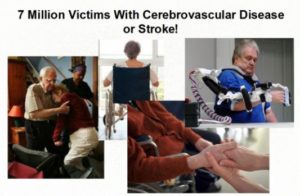There has been a lot of press over the last week about the actor Luke Perry dying from a massive stroke. What makes this even more tragic is that Mr. Perry was only 52 years of age.
The image above was taken on March 31 of 2017. Who would have thought that less than 2 years later Luke Perry would be dead from a massive stroke.
Now I don’t know Mr. Perry. Nor am I familiar with his work.
But what I am familiar with is the devastating effects of a stroke. If it doesn’t kill you, then it will dramatically affect the quality of your life. And whether you live or die it will certainly impact your family and friends.
So rather than write another article about strokes, I’d prefer to point you in the direction of some educationally pieces I’ve done in the past to help educate you on the prevention of strokes. And what conditions to look for to quickly identify a stroke victim. And how to assess your risk for a stroke.
Below you will find links and images that will help you and your loved ones understand this important health topic.
Stroke Prevention – How Nitric Oxide Therapy Can Reduce Your Risk for Stroke
Please watch the video below to understand how nitric oxide therapy can help reduce your risk for a stroke. Then share this video with others.
Stroke Warning Signs – The STR Poster
Click on the image below and then download The STR Poster or print it off as a reminder on what to look for to quickly assess if a person has had a stroke. Please share The STR Poster with others.

The Stroke Risk Assessment Tool
Use the Stroke Risk Assessment Tool to help you determine your risk for a stroke. Just CLICK HERE to go to the blog post that contains this stroke risk assessment tool. Please share this with others.
I hope you find this information helpful.
Blessing Lives Through Nitric Oxide Therapy!
Dan Hammer



 everyone is at risk for a stroke. This assessment tool will help you determine how great your risk is and what areas you could work at to reduce your risk.
everyone is at risk for a stroke. This assessment tool will help you determine how great your risk is and what areas you could work at to reduce your risk. Learning how to address two key factors could make a big difference in stroke prevention. Since stroke is the number one cause of adult disability and the third leading cause of death in the United States, addressing this issue of stroke prevention could be the difference between life or death and permanent disability or significant recovery.
Learning how to address two key factors could make a big difference in stroke prevention. Since stroke is the number one cause of adult disability and the third leading cause of death in the United States, addressing this issue of stroke prevention could be the difference between life or death and permanent disability or significant recovery. According to the most recent statistics from the Centers for Disease Control and Prevention (CDC), more than 29 million Americans have diabetes. However, what makes this “America’s largest healthcare epidemic” is that 86 million Americans are in a pre-diabetic condition, where their blood glucose levels are higher than normal but not high enough to be diagnosed with type 2 diabetes.
According to the most recent statistics from the Centers for Disease Control and Prevention (CDC), more than 29 million Americans have diabetes. However, what makes this “America’s largest healthcare epidemic” is that 86 million Americans are in a pre-diabetic condition, where their blood glucose levels are higher than normal but not high enough to be diagnosed with type 2 diabetes.